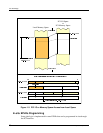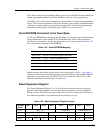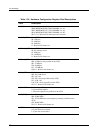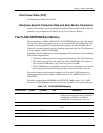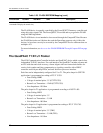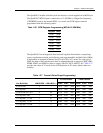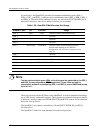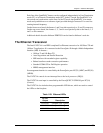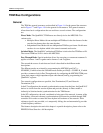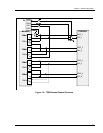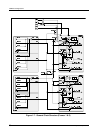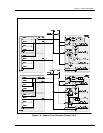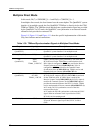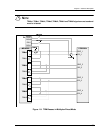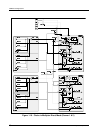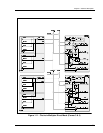
TDM Bus Configurations
34 Interphase Corporation
TDM Bus Configurations
General
The TDM bus general structures are described in Figure 1-6 for the general bus structure
and in Figure 1-7 and Figure 1-8 for the general clock structure. This general structure
allows three basic configurations that can each have several variants. The configurations
are:
Direct Mode: The QuadFALC TDM busses are directly tied to the MPC8260. Two
variants exist:
• Multiplex Direct Mode with one multiplexed TDM bus for the four framers. In that
case the four framers have the same rhythm.
• Independent Direct Mode with one independent TDM bus per framer. Each framer
can have its own rhythm which is the same in transmit and receive.
Switched Mode: The QuadFALC multiplexed TDM bus is tied to the first TDM bus on P4.
The second TDM bus on P4 is tied to the MPC8260.
Pass Through Mode: Special mode that allows line snooping or concurrent treatment. It
applies to framers 1 and 2 together and to framers 3 and 4 together.
The use and the source of each data and clock is described in the different mode
descriptions.
The different modes are selected by programming the MPC8260 port PA(7) =
SWMODE_N which selects the Switched mode and the port PA(0) = COMCLK_N which
provides a common clock in Pass Through mode, by configuring the MPC8260 TDM ports
(open drain output or high impedance input when unused) and by programming the
QuadFALC registers.
Two network configurations are possible, Line Termination (LT) and Network
Termination (NT).
In the LT configuration, the network synchronization comes from the lines: the QuadFALC
derives its clocks from the receive rhythm and provides (directly in Direct mode or
indirectly in Switched mode) synchronization for the TDM busses.
In the NT configuration, the card, considered as being part of the network, is master of the
line rhythm. A network reference synchronization signal must be provided through PMC
connector P4 in order to control the lines rhythm in accordance to the network. If this
reference signal is not provided, or is temporarily failing, the card automatically provides
a fixed frequency reference.
The framers description shown in this chapter is a partial description, please refer to the
PEB22554 Data Sheet for a full description.



